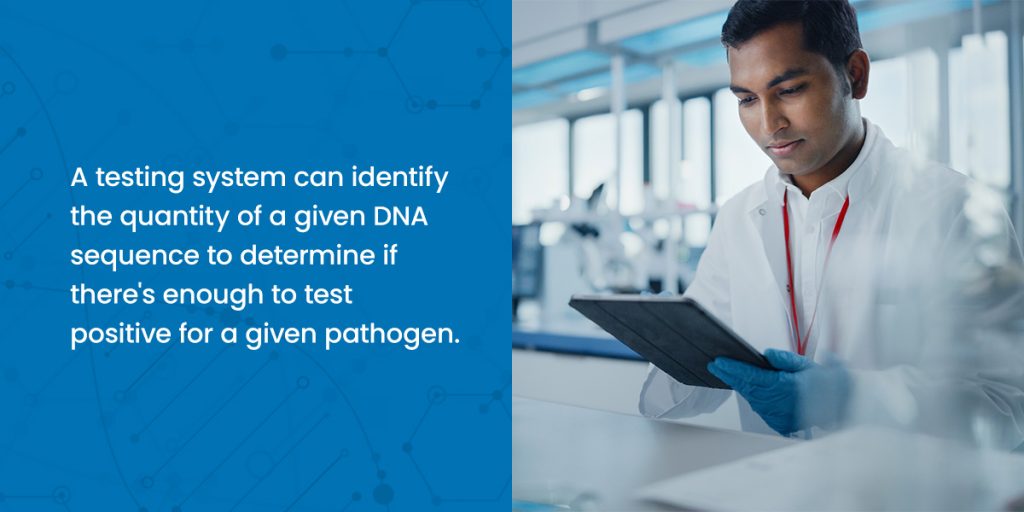Table of Contents
- Gastrointestinal Infections and Their Symptoms
- What Does a Gastrointestinal Panel Test For?
- How a GI Panel Works
- When to Order a GI Panel
- Interpreting Test Results
Gastrointestinal pathogen panels fall under the field of molecular diagnostics. These tests are essential for understanding the cause of gastrointestinal infections (GI). While GI infections can clear on their own, some patients might experience prolonged symptoms. Physicians can turn to gastrointestinal panels to test for multiple pathogens that cause infection.
Gastrointestinal Infections and Their Symptoms
Gastrointestinal infections or gastroenteritis can wreak havoc on your digestive tract when a virus, bacteria, or parasite enters the body. Viral infections are transferred from a sick person to a healthy person, like stomach flu. Bacterial gastroenteritis commonly results from consuming food or water that has become contaminated with bacteria or their toxins. Humans can get parasitic infections from contaminated water or contact with feces.
Common symptoms of gastrointestinal infections include:
- Vomiting
- Nausea
- Abdominal pain
- Fever
- Diarrhea
As infections become more severe, symptoms can be more serious, such as:
- Vomiting blood
- Confusion
- Changes in vision
- Muscle paralysis
What Does a Gastrointestinal Panel Test For?
Gastrointestinal panels test for the pathogens that cause infections. All GI infections present similar symptoms, but the pathogen causing the infection will influence the treatment a person receives. For example, bacteria and parasites can be killed with a course of antibiotics, but viruses cannot.
A gastrointestinal pathogen panel will test for multiple disease-causing microbes in a sample. These panels do so by detecting the RNA or DNA of the common pathogens that can cause infections. Since the panel can detect more than one target, it can also identify co-infections caused by more than one pathogen.
Some of the common pathogens these panels test for include:
- E. coli
- Salmonella
- Shigella
- Norovirus
- Adenovirus
- Giardia lamblia
The common pathogens that GI panels can test for can be quite serious. Norovirus alone is responsible for 109,000 hospitalizations each year. With the prevalence of this GI infection and many others, having the right diagnostic tools is critical for improving care outcomes. Beyond improving care, identifying these microbes is also valuable for eliminating the source of infection. For example, if a patient tests positive for Giardia, this may point to contaminated water in the patient’s area that needs to be fixed.
How Samples Are Collected
A fresh stool sample is required to accurately assess GI pathogens in the body. It’s essential that this sample is not contaminated with water or urine for the panel to provide an accurate reading. To prepare this sample for testing, it must be emulsified in a testing liquid. From there, the sample can be used in the gastrointestinal pathogen panel. Cary-Blair transport media are often used to transfer stool samples to laboratories.
Beyond contamination of the sample, technicians should be aware of storage temperature and the length of time between collection and testing. If the sample is no longer fresh, this might skew the readings of the pathogen panel. Generally, the sample should be tested within 2 hours of collection. If not, a special preservative solution should be used to maintain the validity of the sample.
How a GI Panel Works

GI pathogen panels identify and amplify the genetic material of a given pathogen to detect it in a sample. These multiplex panels do so with the help of a process called polymerase chain reaction (PCR).
PCR tests essentially copy molecules in a sample. The process starts by heating the sample to denature or separate a target DNA sequence into two single strands. Each original strand gets paired with its copied complement. This denaturing and synthesizing process is repeated over and over until there are billions of copies of the exact same DNA strand.
With indicators like fluorescence, a testing system can identify a given DNA target to determine if there are enough copies of a given pathogen. A multiplex panel will target the DNA sequences of multiple pathogens at once.
The PCR process is efficient, especially with the right tools. Generally, PCR tests take a few hours to perform. With the use of multiplex panels, a single testing process can provide results for multiple microbes, improving the overall value of the process.
When to Order a GI Panel
GI panels are not required for every patient who experiences gastroenteritis symptoms. Typically, these panels are only necessary for patients who have diarrhea for a few weeks up to a few months. If a patient has recently traveled to another country, this usually also involves a GI panel. Investigations related to contaminated food or water also require GI panels to understand the outbreak.
Healthcare providers should also order a gastrointestinal panel for patients who have severe symptoms like blood in the stool, vomiting, or fever. GI infections can be especially dangerous for:
- Elderly people and children
- Immunocompromised people
- Individuals who experience prolonged symptoms
Patients in these groups will benefit from a GI panel to inform treatment.
Interpreting Test Results
Physicians will use the results of a GI panel in conjunction with symptoms, health history, and travel history to make informed decisions about a patient’s illness. A positive result for a given pathogen means the target was detected in the sample. It is possible to receive a positive on more than one microbe.
Sometimes positive results can indicate genetic material of dead cells that are not responsible for the infection, but this is not common. If a GI panel comes back completely negative, but a patient still displays symptoms of an infection, physicians will usually investigate further.
A gastrointestinal pathogen panel tests for the most common pathogens responsible for infection. Some patients may be infected with a microbe that’s far less common than those included on a multiplex panel. The GI panel is an excellent first step for understanding a person’s symptoms and how to respond. Often, the results of these panels are enough to guide treatment.
For rarer pathogens, physicians can order ova and parasite (O&P) exams or stool cultures to detect microbes that are not available on the panel.
Get Gastrointestinal Pathogen Panels From Applied BioCode Inc.
The pathogens that a GI panel can detect depend on the manufacturer. At Applied BioCode Inc., our gastrointestinal pathogen panel can detect and identify 17 different GI microbes in a single test.
The key to benefitting from a gastrointestinal pathogen panel is working with the right provider. While there are many of these tests available on the market, the majority cannot test for 17 targets like the pathogen panel from Applied BioCode Inc. Our pathogen panel, paired with the BioCode® MDx-3000 system, can deliver up to 188 samples in an 8-hour shift. Our system also supports masking, so all testing can align with physician orders.
With Barcoded Magnetic Beads (BMB) technology, our panels offer reliable accuracy for pathogen detection. Get in touch with us today to learn more.



